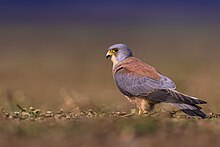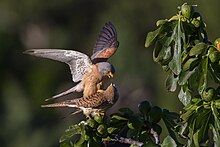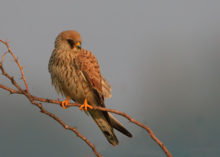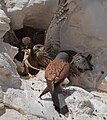| Lesser kestrel | |
|---|---|

| |
| Male | |

| |
| Female | |
|
Scientific classification
| |
| Domain: | Eukaryota |
| Kingdom: | Animalia |
| Phylum: | Chordata |
| Class: | Aves |
| Order: | Falconiformes |
| Family: | Falconidae |
| Genus: | Falco |
| Species: | F. naumanni
|
| Binomial name | |
| Falco naumanni
Fleischer, 1818
| |

| |
| Range of F. naumanni Breeding range Year-round range Wintering range
| |
The lesser kestrel (Falco naumanni) is a small falcon. This species breeds from the Mediterranean [2] across Afghanistan and Central Asia, to China and Mongolia. It is a summer migrant, wintering in Africa and Pakistan and sometimes even to India and Iraq. It is rare north of its breeding range, and declining in its European range. The genus name derives from Late Latin falx, falcis, a sickle, referencing the claws of the bird, [3] and the species name commemorates the German naturalist Johann Friedrich Naumann. [4]
Description


It is a small bird of prey, 27–33 cm (11–13 in) in length with a 63–72 cm (25–28 in) wingspan. It looks very much like the larger common kestrel but has proportionally shorter wings and tail. It shares a brown back and barred grey underparts with the larger species. The male has a grey head and tail like male common kestrels, but lacks the dark spotting on the back, the black malar stripe, and has grey patches in the wings.
The female and young birds are slightly paler than their relative, but are so similar that call and structure are better guides than plumage. The call is a diagnostic harsh chay-chay-chay, unlike the common kestrel's kee-kee-kee. Neither sex has dark talons as is usual in falcons; those of this species are a peculiar whitish-horn color. This, however, is only conspicuous when birds are seen at very close range, e.g. in captivity.
Taxonomy
Despite its outward similarity, this species appears not to be closely related to the common kestrel. In fact, mtDNA cytochrome b sequence analysis places it at a basal position with regards to the other "true" kestrels (i.e., excluding the American kestrel and probably the grey African kestrels as well). [5] Its divergence is tentatively placed to around the Miocene- Pliocene boundary ( Messinian to Zanclean, or about 7–3.5 mya). The morphological similarity with the common kestrel is most puzzling, but still it appears to betray the present species' actual relationships: the lack of a malar stripe seems ancestral for kestrels, and the grey wing colour unites the lesser kestrel with most other Falco species, but not the other true kestrels.

Ecology
The lesser kestrel is, as the name implies, a smaller and more delicate bird than the common kestrel, and it is entirely sympatric in its breeding range with it; they compete to a limited extent. Thus, the possibility that there is some form of adaptive advantage to the similar coloration deserves study. Considering that the lesser kestrel would in fact have an advantage if some would-be predators confused it with the larger species and consequently avoided it, it might be a case of Müllerian mimicry.
The lesser kestrel eats insects, but also small birds, reptiles and rodents (especially mice), [6] which are often taken on the ground. It nests colonially on buildings, cliffs, or in tree holes, laying up to 3–6 eggs. No nest structure is built, which is typical for falcons. On their wintering grounds in West Africa, lesser kestrels favor a "latitude belt" [7] through Senegal where locusts and grasshoppers are plentiful. Surveys of lesser kestrels wintering in January 2007 by the Ligue pour la Protection des Oiseaux revealed them roosting communally. A roost in Senegal discovered during one of the surveys held 28,600 birds, together with 16,000 scissor-tailed kites Chelictinia riocourii. [8]
It is widespread and plentiful on a global scale, and the IUCN have classed it as Least Concern. [1] Apart from possible habitat destruction, it appears that indiscriminate use of pesticides has a strong effect on this species due to its insectivorous habits. [9]
Gallery
-
Lesser Kestrel from Fujeirah
-
Egg, Collection Museum Wiesbaden
-
Lesser kestrel with insect. Notice yellow talons - an easy way to distinguish between lesser and common kestrel
-
Male lesser kestrel feeding chicks
-
Chicks of the lesser kestrel
-
Male lesser kestrel feeding his chicks with Laudakia stellio, Negev desert, Israel
-
Falco naumanni - MHNT
References
- ^ a b BirdLife International (2018). "Falco naumanni". IUCN Red List of Threatened Species. 2018: e.T22696357A131938109. doi: 10.2305/IUCN.UK.2018-2.RLTS.T22696357A131938109.en. Retrieved 12 November 2021.
- ^ MOURAD AMARI, HICHEM AZAFZAF (2001). Tunisia in Important Bird Areas in Africa and Associated Islands: Priority Sites for Conservation, Fishpool, L. D. C. and Evans, M. I., eds (PDF). Cambridge: Pisces Publications, Birdlife International. p. 961.
- ^ Shorter Oxford English dictionary. United Kingdom: Oxford University Press. 2007. p. 3804. ISBN 978-0199206872.
- ^ Jobling, James A (2010). The Helm Dictionary of Scientific Bird Names. London: Christopher Helm. pp. 266. ISBN 978-1-4081-2501-4.
- ^ Groombridge, Jim J.; Jones, Carl; Bayes, Michelle K.; van Zyl, Anthony J.; Carrillo, José; Nichols, Richard A.; Bruford, Michael W. (2002). "A molecular phylogeny of African kestrels with reference to divergence across the Indian Ocean". Molecular Phylogenetics and Evolution. 25 (2): 267–277. doi: 10.1016/S1055-7903(02)00254-3. PMID 12414309.
- ^ McDonnell, K. (2000). ""Falco naumanni" (On-line)". animaldiversity.org. Retrieved 1 December 2008.
- ^ Graham, Rex (17 September 2013). "Tracking by satellite solves bird migration riddles".
- ^ "BirdLife: Surveys Reveal Raptor 'Super-Roost'". 26 April 2007.
- ^ "Species factsheet: Falco naumanni". BirdLife International. 2015. Retrieved 14 April 2015.
External links
- Lesser kestrel species text in The Atlas of Southern African Birds
- Ageing and sexing (PDF; 3.5 MB) by Javier Blasco-Zumeta & Gerd-Michael Heinze
- "Falco naumanni". Avibase.
- "Lesser kestrel media". Internet Bird Collection.
- Lesser kestrel photo gallery at VIREO (Drexel University)
- Audio recordings of Lesser kestrel on Xeno-canto.
| Lesser kestrel | |
|---|---|

| |
| Male | |

| |
| Female | |
|
Scientific classification
| |
| Domain: | Eukaryota |
| Kingdom: | Animalia |
| Phylum: | Chordata |
| Class: | Aves |
| Order: | Falconiformes |
| Family: | Falconidae |
| Genus: | Falco |
| Species: | F. naumanni
|
| Binomial name | |
| Falco naumanni
Fleischer, 1818
| |

| |
| Range of F. naumanni Breeding range Year-round range Wintering range
| |
The lesser kestrel (Falco naumanni) is a small falcon. This species breeds from the Mediterranean [2] across Afghanistan and Central Asia, to China and Mongolia. It is a summer migrant, wintering in Africa and Pakistan and sometimes even to India and Iraq. It is rare north of its breeding range, and declining in its European range. The genus name derives from Late Latin falx, falcis, a sickle, referencing the claws of the bird, [3] and the species name commemorates the German naturalist Johann Friedrich Naumann. [4]
Description


It is a small bird of prey, 27–33 cm (11–13 in) in length with a 63–72 cm (25–28 in) wingspan. It looks very much like the larger common kestrel but has proportionally shorter wings and tail. It shares a brown back and barred grey underparts with the larger species. The male has a grey head and tail like male common kestrels, but lacks the dark spotting on the back, the black malar stripe, and has grey patches in the wings.
The female and young birds are slightly paler than their relative, but are so similar that call and structure are better guides than plumage. The call is a diagnostic harsh chay-chay-chay, unlike the common kestrel's kee-kee-kee. Neither sex has dark talons as is usual in falcons; those of this species are a peculiar whitish-horn color. This, however, is only conspicuous when birds are seen at very close range, e.g. in captivity.
Taxonomy
Despite its outward similarity, this species appears not to be closely related to the common kestrel. In fact, mtDNA cytochrome b sequence analysis places it at a basal position with regards to the other "true" kestrels (i.e., excluding the American kestrel and probably the grey African kestrels as well). [5] Its divergence is tentatively placed to around the Miocene- Pliocene boundary ( Messinian to Zanclean, or about 7–3.5 mya). The morphological similarity with the common kestrel is most puzzling, but still it appears to betray the present species' actual relationships: the lack of a malar stripe seems ancestral for kestrels, and the grey wing colour unites the lesser kestrel with most other Falco species, but not the other true kestrels.

Ecology
The lesser kestrel is, as the name implies, a smaller and more delicate bird than the common kestrel, and it is entirely sympatric in its breeding range with it; they compete to a limited extent. Thus, the possibility that there is some form of adaptive advantage to the similar coloration deserves study. Considering that the lesser kestrel would in fact have an advantage if some would-be predators confused it with the larger species and consequently avoided it, it might be a case of Müllerian mimicry.
The lesser kestrel eats insects, but also small birds, reptiles and rodents (especially mice), [6] which are often taken on the ground. It nests colonially on buildings, cliffs, or in tree holes, laying up to 3–6 eggs. No nest structure is built, which is typical for falcons. On their wintering grounds in West Africa, lesser kestrels favor a "latitude belt" [7] through Senegal where locusts and grasshoppers are plentiful. Surveys of lesser kestrels wintering in January 2007 by the Ligue pour la Protection des Oiseaux revealed them roosting communally. A roost in Senegal discovered during one of the surveys held 28,600 birds, together with 16,000 scissor-tailed kites Chelictinia riocourii. [8]
It is widespread and plentiful on a global scale, and the IUCN have classed it as Least Concern. [1] Apart from possible habitat destruction, it appears that indiscriminate use of pesticides has a strong effect on this species due to its insectivorous habits. [9]
Gallery
-
Lesser Kestrel from Fujeirah
-
Egg, Collection Museum Wiesbaden
-
Lesser kestrel with insect. Notice yellow talons - an easy way to distinguish between lesser and common kestrel
-
Male lesser kestrel feeding chicks
-
Chicks of the lesser kestrel
-
Male lesser kestrel feeding his chicks with Laudakia stellio, Negev desert, Israel
-
Falco naumanni - MHNT
References
- ^ a b BirdLife International (2018). "Falco naumanni". IUCN Red List of Threatened Species. 2018: e.T22696357A131938109. doi: 10.2305/IUCN.UK.2018-2.RLTS.T22696357A131938109.en. Retrieved 12 November 2021.
- ^ MOURAD AMARI, HICHEM AZAFZAF (2001). Tunisia in Important Bird Areas in Africa and Associated Islands: Priority Sites for Conservation, Fishpool, L. D. C. and Evans, M. I., eds (PDF). Cambridge: Pisces Publications, Birdlife International. p. 961.
- ^ Shorter Oxford English dictionary. United Kingdom: Oxford University Press. 2007. p. 3804. ISBN 978-0199206872.
- ^ Jobling, James A (2010). The Helm Dictionary of Scientific Bird Names. London: Christopher Helm. pp. 266. ISBN 978-1-4081-2501-4.
- ^ Groombridge, Jim J.; Jones, Carl; Bayes, Michelle K.; van Zyl, Anthony J.; Carrillo, José; Nichols, Richard A.; Bruford, Michael W. (2002). "A molecular phylogeny of African kestrels with reference to divergence across the Indian Ocean". Molecular Phylogenetics and Evolution. 25 (2): 267–277. doi: 10.1016/S1055-7903(02)00254-3. PMID 12414309.
- ^ McDonnell, K. (2000). ""Falco naumanni" (On-line)". animaldiversity.org. Retrieved 1 December 2008.
- ^ Graham, Rex (17 September 2013). "Tracking by satellite solves bird migration riddles".
- ^ "BirdLife: Surveys Reveal Raptor 'Super-Roost'". 26 April 2007.
- ^ "Species factsheet: Falco naumanni". BirdLife International. 2015. Retrieved 14 April 2015.
External links
- Lesser kestrel species text in The Atlas of Southern African Birds
- Ageing and sexing (PDF; 3.5 MB) by Javier Blasco-Zumeta & Gerd-Michael Heinze
- "Falco naumanni". Avibase.
- "Lesser kestrel media". Internet Bird Collection.
- Lesser kestrel photo gallery at VIREO (Drexel University)
- Audio recordings of Lesser kestrel on Xeno-canto.







